| Article ID | Journal | Published Year | Pages | File Type |
|---|---|---|---|---|
| 5112318 | Journal of Archaeological Science: Reports | 2017 | 10 Pages |
Abstract
This paper applies statistical methods-Ripley's K-function, kernel density estimates and the chi-squared test-to analyze spatially the distribution of archaeological material within two Palaeo-Eskimo tent rings excavated at the LdFa-1 site on Baffin Island, Nunavut. The purpose of this analysis is to determine if there are any statistically verifiable patterns in the distribution of material at this site. Our results indicate that the material inside the tent rings does not follow the spatial segregation of space as laid out by older Palaeo-Eskimo models nor are there any other statistically relevant patterns. Such results outline why it is important for archaeologists to test for spatial randomness prior to inferring any patterns in the distribution of material. Notable differences between the two dwellings we investigated also suggest that statistical tests can be useful to determine if a dwelling is in fact contemporary with recovered artifacts. Finally, our investigation reveals that the common practice of focusing archaeological excavation efforts on interior units within tent ring structures misses important patterns outside of these features.
Related Topics
Social Sciences and Humanities
Arts and Humanities
History
Authors
Dana Thacher, S. Brooke Milne, Robert Park,
